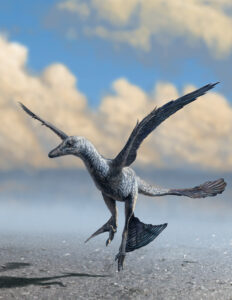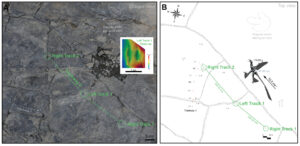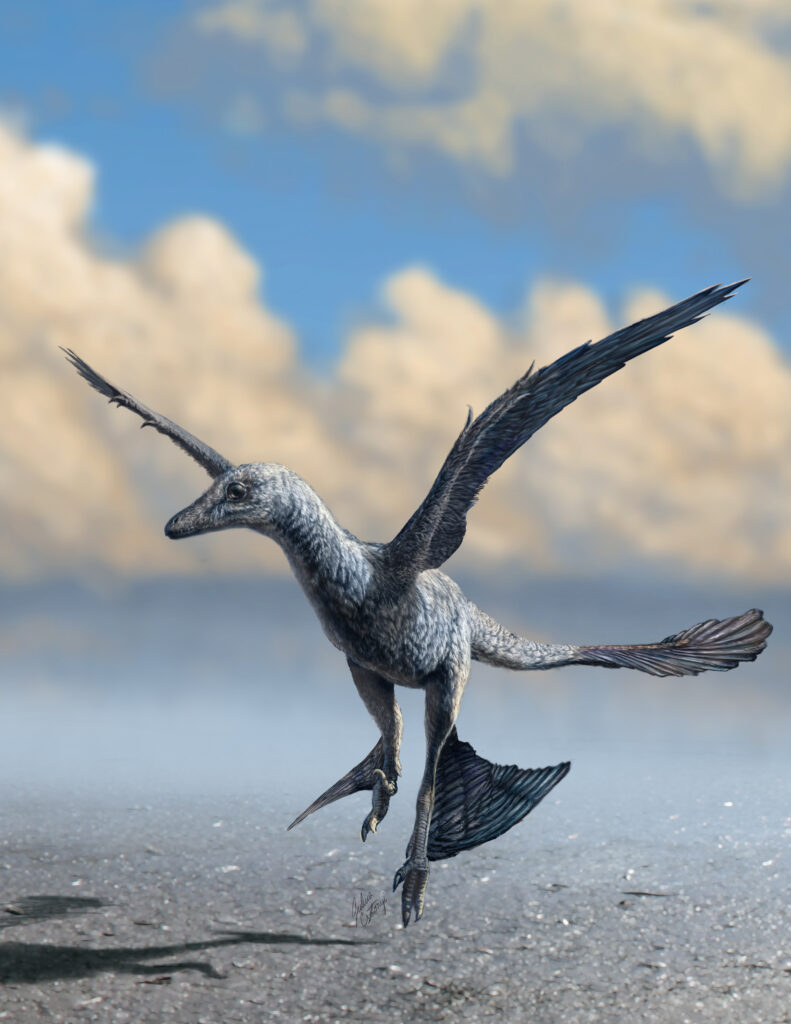CUHK
News Centre
CUHK and Dakota State University palaeontologists reveal “flap running” widely distributed in pre-avian dinosaurs through fossil trackway research
A novel analysis of a South Korean fossil trackway provides indirect support for high-speed wing-assisted locomotion in pre-avian dinosaurs, confirming that this behaviour was not restricted to birds. Led by Dr Michael Pittman, Assistant Professor at The Chinese University of Hong Kong (CUHK)’s School of Life Sciences, and Dr Alex Dececchi, Assistant Professor at Dakota State University in the United States, the research team reanalysed a famous fossil trackway of a fast-moving pre-avian dinosaur to better understand how it was produced. The study has been published in the peer-reviewed journal The Proceedings of the National Academy of Sciences (PNAS).
Researchers reconstructed the locomotion of pre-avian dinosaurs based on their footprints. Such “trace fossils” can record their behaviours while they were alive, providing additional information unavailable from reconstructions based solely on regular “body fossils”. Dr Pittman and his colleagues are specifically interested in how trace fossils can improve our understanding of the origin of flight in birds and their closest theropod relatives.
Dr Pittman, his long-time collaborator Dr Dececchi and their international colleagues explored the locomotion behaviours of a small microraptorine theropod dinosaur (Dromaeosauriformipes rarus) moving at high speed. Their analysis was based on a footprint trackway preserved in the Cretaceous-aged Jinju Formation in South Korea. The ratio of the animal’s stride to its footprint length was about 53, the highest known among a large dataset of 2,637 theropod trackways compiled by the study’s co-author Professor James Farlow of Purdue University Fort Wayne.
The team also reconstructed the hip height of D. rarus by comparing it to 17 microraptorine body fossils. Dr Dececchi said: “Our findings suggest that D. rarus would have needed to run at about 10.5 metres per second to create the trackway using solely hindlimb power. Given that this animal was about the size of a sparrow, such a speed is not realistic. Generally, larger animals can achieve higher absolute speeds. You can make comparisons between a wide range of animals, such as a horse, a dog and a rat, when speed is examined relative to body size. The relative speed shown by our tracks is higher than any living running animal, including ostriches and cheetahs. Instead, we propose that the trackway was produced at lower speeds, with the dinosaur elongating its stride length using the aerodynamic force generated by flapping its feathered arms.”
Regarding the study’s significance, Dr Pittman said: “Although the preserved trackway is not long enough to discern landing or taking off, it does preserve flap-running along a horizontal surface. As such, the study is significant in using trace fossils to better understand pre-avian dinosaurs and the origin of flight in birds. We can now move past debate about whether pre-avian dinosaurs used their arms to help them move before flight evolved, and start to uncover missing details like which species had these abilities, and when and to what extent they were developed.”
Professor Anthony J. Martin, an international authority on modern and fossil traces, and acclaimed author, who was not part of the study, added: “I congratulate the authors for their comprehensive approach in studying this trackway, and thank them for giving future workers the means for finding more such trackways, which are likely far more common than supposed.”
The international team included Professor Kyung Soo Kim of Chinju National University of Education in South Korea, who excavated the trackway. The study is dedicated to the memory of coauthor Professor Martin G. Lockley, who inspired generations of scholars through his pioneering trackway research.
The full research paper can be found at: https://www.pnas.org/doi/10.1073/pnas.2413810121

A research team led by CUHK and Dakota State University scholars discovered that a famous pre-avian dinosaur trackway was produced by the animal flapping its arms to help it run at high speed. This “flap running” behaviour probably just preceded takeoff or just followed landing. The team’s findings confirm that pre-avian flap running was not limited to birds.
Image Credit: Julius T. Csotonyi.

“Trackway 2” records the two-toed tracks of a pre-avian dinosaur as it moved quickly across a South Korean lake shore about 106 million years ago, during the Lower Cretaceous. Picture A shows the trackways and a 3D depth model of one track. Picture B is a schematic drawing of the trackway and its maker.





